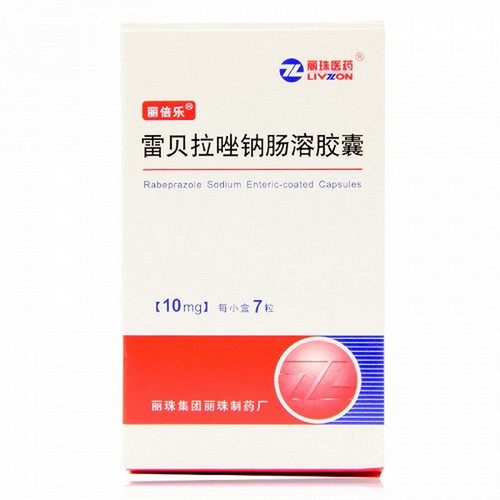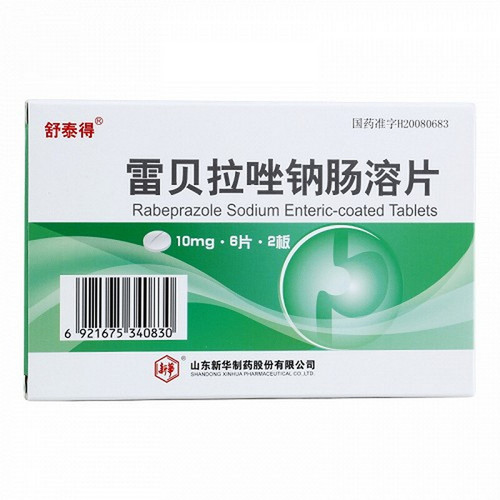Product Overview
[Drug Name]
Trade Name: Yutianqing
English Name: Rabeprazole Sodium Enteric-coated Capsules
Chinese Pinyin: Leibeilazuona Changrong Jiaonang
[Ingredients]
The main ingredient of this product is rabeprazole sodium.
[Properties]
This product is an enteric-coated capsule containing off-white coated micropellets.
[Indications]
Gastric ulcer, duodenal ulcer, anastomotic ulcer, reflux esophagitis, Zollinger-Ellison syndrome (gastrinoma), and adjunctive treatment for Helicobacter pylori eradication in patients with gastric or duodenal ulcer.
[Dosage and Administration]
Gastric ulcer, duodenal ulcer, anastomotic ulcer, Zollinger-Ellison syndrome: Generally, adults take 10 mg of this product orally once daily; 20 mg may be taken orally once daily depending on the condition. In general, the treatment course for gastric ulcers and anastomotic ulcers should not exceed 8 weeks, and for duodenal ulcers, should not exceed 6 weeks.
Reflux Esophagitis:
Usually, adults take 10 mg of this drug orally once daily; depending on the condition, 20 mg can be taken orally once daily. In general, the treatment course for reflux esophagitis should not exceed 8 weeks. For maintenance treatment of persistent and recurrent reflux esophagitis, take 10 mg of this drug orally once daily.
Note:
For severe, recurrent, or refractory cases of the above conditions, 20 mg of this drug orally once daily is recommended (except for maintenance treatment of recurrent reflux esophagitis).
Adjunctive use for Helicobacter pylori eradication in patients with gastric or duodenal ulcers:
Usually, adults take 10 mg of this drug orally, along with 750 mg of amoxicillin and 200 mg of clarithromycin, twice daily for 7 consecutive days. The dose of clarithromycin can be increased as needed, with a maximum dose of 400 mg twice a day.
[Adverse Reactions]
Gastric ulcer, duodenal ulcer, anastomotic ulcer, reflux esophagitis, Zollinger-Ellison syndrome: Adverse reactions were reported in 55 cases (3.84%) of 1,434 subjects in a clinical trial in Japan. In addition, 113 cases (7.88%) had abnormal laboratory test values (at the time of marketing approval). Adjunctive use for eradication of Helicobacter pylori in patients with gastric or duodenal ulcer: Adverse reactions were reported in 205 cases (40.35%) of 508 subjects in a clinical trial in Japan. 1. Serious adverse reactions (1) Shock and anaphylactic reactions: This product may cause shock (incidence unknown) or anaphylactic reactions (incidence unknown). Therefore, patients should be closely observed during treatment. If such abnormal conditions occur, the drug should be discontinued and appropriate treatment should be taken. (2) Pancytopenia, agranulocytosis, thrombocytopenia and hemolytic anemia: This product may cause pancytopenia (incidence unknown), agranulocytosis (incidence unknown), thrombocytopenia (0.1% to 5%) and hemolytic anemia (incidence unknown). Therefore, if such abnormal conditions occur, the drug should be discontinued and appropriate treatment should be taken. (3) Fulminant hepatitis, liver dysfunction and jaundice: This product may cause fulminant hepatitis (incidence unknown), liver dysfunction (0.1% to 5%) and jaundice (incidence unknown). Therefore, if such abnormal conditions occur, the drug should be discontinued and appropriate treatment should be taken. (4) Interstitial pneumonia: This product may cause interstitial pneumonia (0.1%). If fever, cough, dyspnea and abnormal breath sounds (crackles) occur, chest X-ray or other examinations should be performed immediately, the drug should be discontinued and appropriate treatment should be taken, such as treatment with steroid corticosteroids. (5) Toxic epidermal necrosis (Lyell syndrome), mucocutaneous ocular syndrome (Stevens-Johnson syndrome) and erythema multiforme: This product may cause skin diseases such as Lyell syndrome (incidence unknown), Stevens-Johnson syndrome (incidence unknown) and erythema multiforme (incidence unknown). The patient should be closely observed during treatment. If such abnormal conditions occur, the drug should be discontinued and appropriate treatment should be taken.
[Contraindications]
This product is contraindicated in patients who are allergic to rabeprazole sodium or any excipients in the prescription.
[Precautions]
1. This product contains enteric-coated microcapsules. Patients should be careful not to chew or crush them when taking them. They should be swallowed whole. 2. Taking this product may mask symptoms caused by gastric cancer. Therefore, it should be started only after the diagnosis of non-malignant tumors is confirmed. 3. This product should be used with caution in patients with a history of drug allergies, liver dysfunction (there are reports of hepatic encephalopathy in patients with cirrhosis after taking the drug) and elderly patients. 4. When using this product, the patient's condition should be closely monitored, and the dosage should be kept to the lowest dose required for treatment. Because there is insufficient long-term experience with this product, it is not suitable for the ongoing treatment of gastric ulcers, duodenal ulcers, or anastomotic ulcers. 5. For maintenance treatment of reflux esophagitis, this product is only suitable for recurrent and refractory cases and should be avoided in patients who do not require maintenance treatment. The product should be discontinued when the patient's diet and alcohol consumption have improved and there has been no relapse for a considerable period of time. Close monitoring (e.g., regular endoscopic examinations) is recommended during maintenance treatment. 6. Long-term safety studies of this product for the recovery and maintenance treatment of reflux esophagitis are lacking in Japan, its country of origin (there is no experience with this product for more than six months in Japan, but there is experience with this product for more than one year in other countries). 7. When this product is used as an adjunct to Helicobacter pylori eradication in patients with gastric or duodenal ulcers, the contraindications, cautions, serious adverse reactions, and other precautions indicated in the product package inserts for amoxicillin and clarithromycin should be reviewed. 8. Precautions Regarding the C-urea Breath Test: A C-urea breath test may show false-negative results during or shortly after discontinuation of proton pump inhibitors (e.g., rabeprazole sodium) and antibiotics (e.g., amoxicillin and clarithromycin). Therefore, a C-urea breath test should be performed 4 weeks after discontinuation of these medications to assess H. pylori eradication efficacy. 9. Long-term use of this drug has been reported to cause benign gastric polyps. 10. Increased thyroid weight and elevated blood thyroxine levels have been observed in rats following oral administration of 25 mg/kg/day or higher. Thyroid function should be monitored during clinical use of this drug.
[Use in Special Populations]
Precautions for Pediatric Use:
There is no clinical experience or safety data for this drug in children; its use is not recommended.
Precautions for Pregnancy and Lactation:
1. This drug should only be used by pregnant or potentially pregnant women only when the benefits clearly outweigh the risks. 2. This drug should be avoided by lactating women. If necessary, breastfeeding should be discontinued.
Precautions for Elderly Patients:
This product should be used with caution in the elderly. This product is primarily metabolized in the liver, and elderly individuals generally have reduced liver function, making adverse reactions more likely. Therefore, if adverse reactions occur, temporary discontinuation of the drug and monitoring should be implemented.
[Drug Interactions]
1. Rabeprazole sodium is metabolized by the cytochrome P450 (CYP450) metabolic enzyme system. Studies in healthy subjects have shown that rabeprazole sodium does not have significant clinical interactions with other drugs metabolized by the CYP450 system. 2. Rabeprazole sodium can produce a sustained inhibitory effect on gastric acid secretion. Because rabeprazole sodium decreases acidity, it may interact with drugs whose absorption is dependent on gastric pH. For example, daily administration of ketoconazole and 20 mg of rabeprazole sodium in healthy subjects decreased ketoconazole bioavailability by approximately 30%. Concomitant administration of digoxin increased digoxin's AUC and Cmax by 19% and 29%, respectively. Therefore, patients should be monitored when taking these drugs concurrently with rabeprazole sodium. When rabeprazole sodium is taken concurrently with antacids or one hour after antacid administration, the mean plasma concentration area under the curve decreases by 8% and 6%, respectively. There are reports of delayed metabolism or excretion of phenytoin when omeprazole, a similar drug, is taken concurrently with phenytoin.
[Pharmacological action]
Pharmacological action Mechanism of action This product is converted into an active form (sulfinyl form) under acidic conditions in gastric parietal cells, and inhibits the activity of H', K*-ATPase and gastric acid secretion by modifying the sulfhydryl group of the proton pump (H', K"-ATPase). The recovery of H', K'-ATPase activity is mainly due to the elimination of the drug from the site of action, and glutathione may also be involved in the recovery of enzyme activity. Animal pharmacology (1) In vitro inhibition of H', K*-ATPase Rabeprazole sodium inhibits H', K*-ATPase prepared from porcine gastric mucosa. (2) Inhibitory effect on gastric acid secretion Rabeprazole sodium can inhibit the gastric acid secretion of rabbit gastric glands induced by dibutyl cyclophosphophosphate in vitro. In dogs with indwelling gastric fistula tubes, rabeprazole sodium inhibits the gastric acid secretion induced by histamine and pentagastrin; in rats, it inhibits basal gastric acid and gastric acid secretion induced by histamine. (3) Anti-ulcer effect Rabeprazole sodium has shown significant therapeutic effects on various experimental ulcers and experimental gastric mucosal lesions in rats (induced by cold stimulation stress reaction, water immersion stress reaction, pyloric ligation, cysteamine or ethanol-hydrochloric acid). (4) Auxiliary use for the eradication of Helicobacter pylori In the gerbil animal model infected with Helicobacter pylori, rabeprazole sodium can enhance the synergistic effect of amoxicillin and clarithromycin by counting viable bacteria in gastric juice. During the triple administration of rabeprazole sodium, amoxicillin and clarithromycin, rabeprazole sodium causes an increase in gastric pH, thereby enhancing the antibacterial activity of amoxicillin and clarithromycin. Toxicological studies Reproductive toxicity: In animal experiments (400 mg/kg orally administered to rats and 30 mg/kg intravenously administered to rabbits), rabeprazole sodium was found to be embryotoxic (rats showed delayed ossification, rabbits showed weight loss and delayed ossification). This product can be secreted into rat milk. Carcinogenicity: Oral administration of rabeprazole sodium at doses of 5 mg/kg/day or higher for two years resulted in benign gastric tumors in female rats.
[Storage]
Store in a dark, airtight container in a cool, dark place (not exceeding 20°C).
[Specifications]
10 mg
[Packaging]
Aluminum-plastic packaging, 4 tablets per box
[Expiry Life]
24 months.
[Approval Number]
National Medicine Standard H20050228
[Manufacturer]
Zhuhai Rundu Pharmaceutical Co., Ltd.








